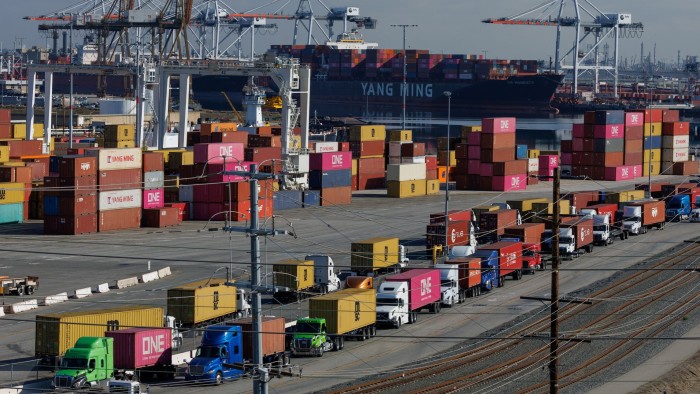Unlock the White House Watch newsletter for free
Your guide to what the 2024 US election means for Washington and the world
When it came to it, Donald Trump held back from activating tariffs on Canada and Mexico that he had announced days earlier. Yet even if the US president’s tariff-raising agenda does not reach its full extent, multinational companies must learn to live in a hyper-uncertain world. North American auto executives this week began preparations for a supply chain shock that could be more disruptive than the Covid-19 pandemic, even as duties on US neighbours were postponed for 30 days. The spirits giant Diageo scrapped its sales target, citing a lack of clarity in the US, its largest market. Barbie doll maker Mattel warned it may raise prices in America to offset the impact of any tariffs on its global manufacturing bases.
Indicators of economic uncertainty have shattered records reached in Trump’s first term. His second administration is showing a greater willingness to use executive orders to threaten tariffs, even against allies. Despite this week’s postponements, it is unwise for businesses with supply chains that feed the world’s largest consumer market to assume that the president sees trade sanctions only as a negotiating tool. An additional 10 per cent tariff on China has taken effect. Other targeted nations are busy devising retaliatory measures.
Businesses cannot stand still. Wall Street analysts are imploring US companies to explain how they will mitigate tariff war risks. Given the potential disruption, risk-mapping and contingency planning is a sensible first step. In some cases, inputs criss-cross America’s borders with Mexico and Canada several times before reaching the retailer, complicating the impact of higher duties throughout the production line. Intense lobbying activity for carve-outs will add further complexity. Even those not directly hit by tariffs will be affected, as uncertainty eats into Trump’s opposing efforts to excite animal spirits.
What can businesses do? The delay to Mexican and Canadian duties may allow some US-based companies to build reserves. Indeed, the surge in Chinese exports last year was partly attributed to the front-loading of stocks ahead of possible tariff disruption. Others might consider reconfiguring product designs and inputs to skirt tariff definitions. That is, however, a high-risk approach when Trump’s team are also touting universal duties. For importers anticipating price rises to protect margins, there may even be scope to capture market share by undercutting competitors.
Over time businesses will need to re-evaluate their broader sourcing, production and distribution operations. Supply chain diversification, particularly away from China, has progressed since the pandemic. But now even those de-risking and “friendshoring” efforts are at risk. The administration has cottoned on to “China Plus One” strategies of shifting some production to third countries, such as Mexico and Vietnam, to export into America. Still, assessing new sourcing routes and logistics hubs and finding new markets can provide operational flexibility. This can be costly, but it hedges against rising geopolitical tensions. By forcing businesses to look at alternative fast-growing markets it can also be fruitful.
Then there’s the option of relocating production to the US, which may be the ultimate goal of Trump’s tariffs. This makes most sense for manufacturers of highly competitive, niche products such as chips. Taking this route, however, comes at a price — in factory openings and expensive labour, made scarcer by a clampdown on immigration.
Trump’s shoot-from-the-hip style and love of tariffs are a recipe for volatility. But in the face of disruption ranging from Covid to Russia’s invasion of Ukraine, supply chains have already shown unexpected agility and resilience. The winners in this latest era of uncertainty will be those businesses that once again show they can think on their feet.
Read the full article here




